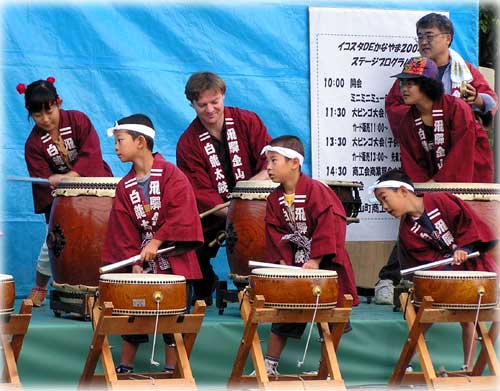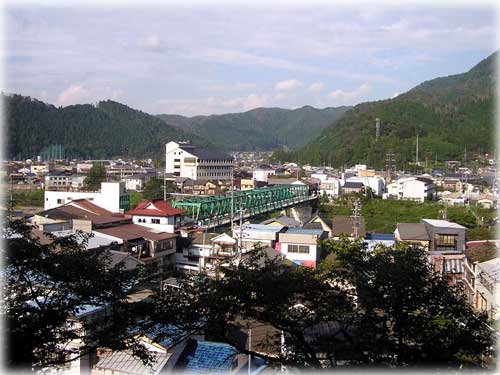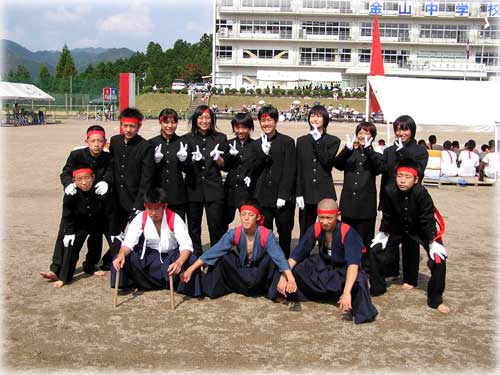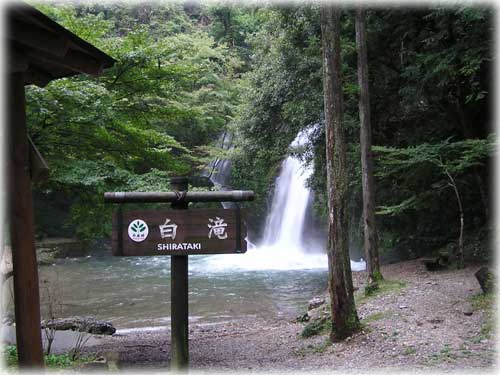 Kanayama... Ketchikan's Sister
City
Kanayama... Ketchikan's Sister
City
by Daniel Patton
November 02, 2004
Tuesday
In 1986, through the work of many forward-thinking politicians
and educators on both sides of the Pacific, Ketchikan and Kanayama,
Japan began a sister city relationship. Since then, over 500
middle school students, 36 teachers, several political delegations
and cultural emissaries (Alaska Native dancers, Japanese Taiko
drummers, Japanese flower arrangers) have made the 9,000 mile
journey across the North Pacific to participate in cultural and
educational enrichment. This remarkably successful sister city
arrangement is one of the longest running Japanese-American exchange
programs in either nation.
 Several local elementary
school children and Dan Patton performing
Several local elementary
school children and Dan Patton performing
on the Japanese Tiako drums at a local festival.
Ohayo Gozaimasu Citizens of Ketchikan!
Hello, this is Dan Patton,
the 2004-2005 Ketchikan-Kanayama exchange English teacher, checking
in from the beautiful city of Kanayama, Japan. I'm excited to
use sitnews.us as a way to spread awareness of this exceptional
program, Kanayama, and Japan! Most people in Ketchikan have at
least heard of the exchange program and many have had friends
or relatives who have been to Kanayama. However, the perceptions
are somewhat vague. I hope, through a series of articles I will
write this year, to give Ketchikanites a glimpse of what everyday
life is like here in their sister city. I want to tell you about
the Kanayama's people, schools, jobs, food, entertainment, economics,
history, naturethe list goes on and on. Mostly, however, I want
to encourage more people to get involved personally with the
program and maybe even motivate some to make the journey to Kanayama
themselves.
So putting first thing first,
where exactly is Kanayama, and what does it look like here?
 Part the town of Kanayama
taken from the Kanayama Elementary school.
Part the town of Kanayama
taken from the Kanayama Elementary school.
Kanayama is located in a very mountainous region of Japan known
as Gifu Prefecture. If you have a map of Japan in front of you
(there are some good ones at google.com 'images'), look in the
southern part of the main island, Honshu, about 60 miles north
of Nagoya City. You'll see that Kanayama is in the foothills
of the Japanese Alps, a rugged mountain range to the north with
peaks approaching 10,000 ft. The mountains around Kanayama are
lower, in the range of 1,500-2,000 ft, very steep, and covered
in dense forest. The trees are largely evergreen, including Japanese
varieties of cedar and hemlock. There are also several deciduous
varieties in the mix, including the Japanese maple, a tree whose
leaves turn vivid red in the fall. Minus the ocean, the geography
of Kanayama is very similar to Ketchikan's. Just about every
window in town looks outs to green mountainsides. Cold, swiftly
flowing creeks and streams curse through the valleys and waterfalls
abound. Hiking in the forest here is a lot like hiking in Ketchikan;
there is a dense canopy overhead, a wide variety of ferns, and
lots of fungus covered fallen wood. And it rains quite a bit
here too!
 Kanayama Jr. High
students taken during the annual sports festival held in
September. The students pictured are about to compete in
a cheering competition called `oendan` in Japanese.
Kanayama Jr. High
students taken during the annual sports festival held in
September. The students pictured are about to compete in
a cheering competition called `oendan` in Japanese.
Kanayama is a small city, especially by Japanese standards, with
around 8,000 residents. Downtown Kanayama is built at the confluence
of two sizeable rivers. Several bridges, including a few that
resemble longer versions of our Thomas Basin bridge, span the
rivers. The houses and businesses are packed tightly together
along narrow streets, their fronts reaching right up to the edge
of the street. Downtown Kanayama is reasonably vibrant. There
are banks, bakeries, clothing and shoe stores, bookstores, small
butcher shops, restaurants, etc. However, in recent years many
of the smaller downtown business have closed as a result of a
tendency toward building larger stores on the outskirts of towns.
Sound familiar? Kanayama also includes two outlying neighborhoods,
roughly equivalent to Ketchikan's 'out north' and 'out south'.
Higashi and Sugata, as they are known locally, extend into narrow
valleys that branch out from downtown.
When I arrived, I was surprised
to see large expanses of virtually wild country. I had fallen
into the popular myth that Japan was 'paved over'. While it is
true people have been living here for thousands of years and
just about every watershed has some sort of road or path running
up it, the sheer geography of this mountainous area prohibits
people from colonizing the majority of the land. Thus, there
is still quite a bit of wildlife to be seen. In the short time
I've been here I've already seen several deer, monkeys, herons,
falcons, and gorgeous butterflies (something this region of Japan
is famous for). There are even bears, the Asian Black bear to
be specific (or Moon Bear locally), that live in the forest.
Lately, they have been causing problems by getting into garbage,
raiding gardens, and terrorizing citizens. Sound familiar?
 The Shirataki waterfall
near downtown Kanayama
The Shirataki waterfall
near downtown Kanayama
This time of year Kanayama is especially beautiful because the
deciduous trees have begun to show their fall foliage. For the
next month or so the mountain sides will be a stunning mix of
reds, yellows, and greens. Tucked between the river banks and
mountain sides are beautifully terraced rice paddies. Like Ketchikan,
there is precious little flat ground around here. These days
there is only stubble in the paddies, but in each field last
month you could see harvested rice stalks bundled together and
hanging to dry on wooden racks. After they were dry the rice
was separated and the stalks were burnt. The aromatic smell of
burning rice stalks often filled the air. Now, busy gardeners
are working to harvest vegetable crops before the first freeze.
Along the creeks and rivers it's common to see anglers with their
distinctive Asian style straw hats and incredibly long bamboo
fishing poles trying to hook into trout and aiyu, a small trout-like
fish that is a local delicacy. On the roads are many tourists,
eager to leave the city and experience the countryside, if only
for the weekend. A big draw tourist draw in this region is the
many onsens: public bath houses built around flows of hot, geothermic
water. The Japanese place great value on the medicinal qualities
of hot spring water and come from miles around to soak and relax
in the region's onsens.
Thanks for reading this article
and if you are interested, please get involved with the exchange
program. If your child is in Jr. High, encourage him or her to
apply for the exchange. If you are interested in teaching English
abroad, apply to be the exchange teacher next year. If you are
involved in a cultural activity, consider coming to Kanayama
and sharing it with our sister city. Or, if you are simply interested
in Japan and the Japanese lifestyle, come to Kanayama as a tourist.
I'm sure as a Ketchikanite you would be warmly received. As the
ties between Ketchikan and Kanayama grow, the benefits will certainly
follow. More on this later and feel free to email me with questions
of if you want more information.

Dan Patton
experiencealaska@yahoo.com
Dan Patton ©2004
2004-2005 Exchange Teacher
E-mail your news &
photos to editor@sitnews.org
Publish A Letter on SitNews Read Letters/Opinions
Submit
A Letter to the Editor
Sitnews
Stories In The News
Ketchikan, Alaska
|




